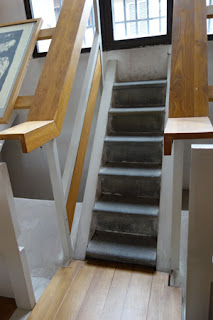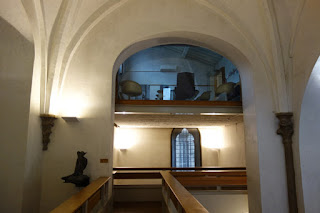This post about the Museo Marino Marini of
the sculptures and drawings of the late Tuscan artist Marino Marini (1901-1980)
will focus on the architecture of the building in central Florence, Italy. The space was once the church of San Pancrazio
[a saint that I have never heard of, but to be fair, that is not unusual for
me] and it is located in a piazza [open square] of the same name.
The Romanesque church dates back to the 9th-11th
century AD. It was reconstructed in the
seventeenth and early nineteenth centuries.
At some point, probably in the late 1900s, it was deconsecrated, and
redesigned for public use, especially cultural activity. It was donated to the City of Florence in 1980. Marino Marini was from Pistoia, a Tuscan city
[this year it was awarded the City of Culture in Italy and many events were
happening in this jewel of a town that I have yet to visit]. In any case, Marino Marini spent enough time working
in Florence
that the Florentines decided to honor him with a museum permanently showcasing
his works, while the underground floor hosts guest artists. There is another Marino Marini museum in Pistoia.
The restoration work of the ancient church, reconstructed in the seventeenth and early nineteenth centuries, devoted to civilian purposes, which had profoundly changed its appearance, were initiated in 1982 and concluded in 1986.
 |
| Angled catwalks to different levels. |
Architects Lorenzo Papi and Bruno Sacchi were responsible for the re-design of the space. I understand their changes started in 1982 [the year that I graduated high school and one of my sisters was born while I started at university]. It ended in 1986. If you did not know this had been a church, you might not think of it. Although I believe that the high ceiling dome [over where the altar would have been], with its half-decayed fresco, is perhaps your biggest clue. Read more on the Wikipedia page link below if you are interested in their description of how the architecture was changed and what the architects wanted to emphasize about the work of the Italian sculptor.
The wooden “catwalks” and angular balconies and overall design are a contrast to the graceful curves in the former place of worship, but perhaps are a transition between what I found to be the harsh straight lines and angles in many of Marini’s compositions. I think the teak-colored wood and rusty/burgundy accent colors are peaceful and a good compliment to the whitewashed walls and some grey stone [pietra serena] of the building. Nice to see sculpture from many viewpoints. I hope that you enjoy some of my snapshots during my recent visit.
 |
| Curves and angles make the world a more interesting place! |
 |
| I like it that they kept some of the history of the place. |
 |
| . . . and tried to hide the "modernization," although this looks about from 1980s. |
 |
| The top catwalk shows drawings and a hint of the dome fresco. |
 |
| I love these steep stairs that go to the windows. |
Past posts on the same subject:
The sculptures by Marino Marini
in Florence, Italy:
The drawings by Marino Marini:
Helpful related links:
Happy birthday to my charming
and dancing niece, Elyse!
Peace,
Kelly Borsheim, artist
P.S. IF original art, while
affordable, is STILL a bit out of your budget, or the piece you adored has
sold? Or do you like arty things in
different formats, to surround yourself with art? Looking for a gift? See my store online for pillow, phone cases,
shower curtains, towels, tote bags, and yes, even prints on metal, wood,
canvas, and so much more:



No comments:
Post a Comment